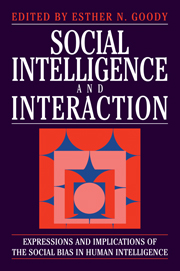 Social Intelligence and Interaction
Social Intelligence and Interaction Published online by Cambridge University Press: 09 January 2010
In this chapter I want to discuss what has been called the ‘narrative mode of understanding’ (Bruner 1986), the ability to create, narrate, and comprehend stories. This ability enables us, I suggest, to grasp a flow of social events and to convey that grasp to others. To share stories in this way is a particularly powerful form of interactive planning: for in fashioning an account of what has been happening and what is happening, we lay down the background against which future mutual action may sensibly unfold. Stories, moreover, have the capacity to frame a markedly intricate and elaborate flow of social events, indeed just the sort of flow that seems even more characteristic of human than of other social primate societies (Byrne and Whiten 1988; Whiten 1991; Carrithers 1991a, 1992). We understand our social world by means of stories, and we use those stories to create distinctively human society.
The general idea
As I understand it, narrative thinking differs from, but complements, the other means of interactive planning discussed in this volume. This is partly a matter of scale. Conversation and discourse analysis (Streeck, Drew, Brown, this volume) work usually on two interlocutors interacting for perhaps no more than a few seconds or minutes. On the other hand, narrative thought may easily comprehend more – sometimes many more – than two people and may cover days, years, or even a lifetime and beyond.
To save this book to your Kindle, first ensure no-reply@cambridge.org is added to your Approved Personal Document E-mail List under your Personal Document Settings on the Manage Your Content and Devices page of your Amazon account. Then enter the ‘name’ part of your Kindle email address below. Find out more about saving to your Kindle.
Note you can select to save to either the @free.kindle.com or @kindle.com variations. ‘@free.kindle.com’ emails are free but can only be saved to your device when it is connected to wi-fi. ‘@kindle.com’ emails can be delivered even when you are not connected to wi-fi, but note that service fees apply.
Find out more about the Kindle Personal Document Service.
To save content items to your account, please confirm that you agree to abide by our usage policies. If this is the first time you use this feature, you will be asked to authorise Cambridge Core to connect with your account. Find out more about saving content to Dropbox.
To save content items to your account, please confirm that you agree to abide by our usage policies. If this is the first time you use this feature, you will be asked to authorise Cambridge Core to connect with your account. Find out more about saving content to Google Drive.